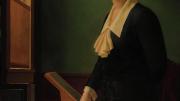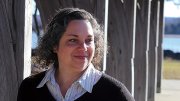Affirmative action for portraits,” was how Nobel laureate Dudley R. Herschbach, Baird professor of science, described the oil painting of Cecilia Payne-Gaposchkin that he and his wife, associate dean of the College Georgene Botyas Herschbach, had commissioned. For years, he had argued that there were too few women on the faculty, and too little recognition for the few there were. The portrait would hang in University Hall’s Faculty Room where, in the winter of 2002, there was only one other painting of a woman: historian Helen Maud Cam.
At the dedication, Jeremy Knowles, dean of the Faculty of Arts and Sciences, told the audience: “Every high-school student knows that Newton discovered gravity, that Darwin discovered evolution, even that Einstein discovered relativity. But when it comes to the composition of our universe, the textbooks simply say that the most prevalent element in the universe is hydrogen. And no one ever wonders how we know.” As she was then, Payne-Gaposchkin is today: the most famous astronomer you’ve never heard of.
English-born Cecilia Helena Payne early on displayed a relentless desire to learn. She once asked a London bookbinder to put a fake cover on the Apology and inscribe “Holy Bible” on the spine, so her teachers would think she was working on her religion studies instead of reading Plato. (The bookbinder refused.) That attitude got her expelled from her Catholic school a year shy of college. Luckily for science, she was accepted to the demanding St. Paul’s School for Girls in London. The moment she walked through the door, she said to herself, “I shall never be lonely again. Now I can think about science!” After a wild year of study—mechanics, Newtonian equations of motion, thermodynamics, astronomy—she was accepted to Cambridge.
For its first 700 years, Cambridge was strictly male. In 1865, as women started talking about attending, a geology professor pronounced them “nasty forward minxes.” When Cecilia Payne—neither nasty nor a minx, but definitely forward—enrolled in 1919 at Newnham, one of the two women’s colleges, she complied with the tradition that men studied mathematics; women majored in botany.
All that changed on the night of December 2, when Arthur Eddington, head of the Cambridge Observatory, lectured on his recent solar expedition, which had proved Einstein’s theory of relativity. Payne, one of four women in the audience, raced back to her dorm room and transcribed the lecture word-for-word into a notebook. “For three nights, I think, I did not sleep,” she recalled. “My world had been so shaken that I experienced something like a nervous breakdown.”
She changed her major to physics, with all the astronomy she could pick up on the side. It was challenging. She bicycled to the Cavendish Laboratory in a full-length dress and a hat (required to enter town), and, as a woman, had to sit in the front row. The lab’s director, Nobel laureate Ernest Rutherford, would look directly at her and begin each lecture with, “Ladies and gentlemen.” She recalled that “all the boys regularly greeted this witticism with thunderous applause…and at every lecture I wished I could sink into the earth.”
Unable to get an astronomy job in England when she graduated, she applied for a fellowship at the Harvard College Observatory. Its director, Harlow Shapley, offered her a $500 stipend. Arriving in the fall of 1923, she met the observatory’s hard-working women “computers” who across four decades had produced nine 250-page volumes of stellar spectra. Those stellar data, etched into thousands of glass plates, made up a giant jigsaw puzzle waiting for the right person to fit it together. By looking down through a jeweler’s loupe, Payne was able to do what centuries of astronomers had tried to do by looking up through telescopes: determine what stars are made of.
That was the birth of astrophysics—and when the trouble started. In 1925, Payne submitted what’s been called “the most brilliant Ph.D. thesis ever written in astronomy” to earn Harvard’s first doctorate in her field (albeit awarded by Radcliffe). She determined that hydrogen was a million times more prevalent in the universe than the experts believed; Henry Norris Russell, dean of American astronomers and head of the Princeton Observatory, wrote her that the findings were “clearly impossible.” Her book Stellar Atmospheres therefore stated that her results were “almost certainly not real.” Four years later, Russell proved her results correct by a different method. He got the credit.
Astronomy, meanwhile, continued to consume Payne, though she made time for a personal life. She spirited Sergei Gaposchkin, her husband-to-be, out of Nazi Germany and they had three children. She worked tirelessly in the observatory for woeful pay—which came from Shapley’s equipment budget. And though she taught numerous astronomy courses, her name was missing from the course catalog. Harvard president Abbott Lawrence Lowell had declared that because she was a woman, “Miss Payne should never have a position in the university” as long as he was in office.
Through it all, she persevered. On June 21, 1956, The New York Times reported, “Harvard University announced today the appointment of Dr. Cecilia Payne-Gaposchkin as Professor of Astronomy. She is the first woman to attain full professorship at Harvard through regular faculty promotion.”
Today, a painting of President Lowell dominates the north wall of the Faculty Room. Surely, Payne-Gaposchkin would appreciate the irony: in her portrait, because her eyes look left and slightly up, she is gazing directly at Lowell, no more than 30 feet away.








